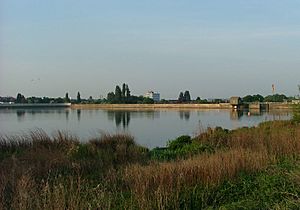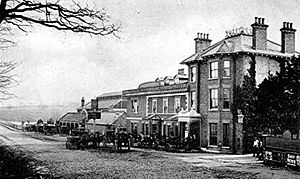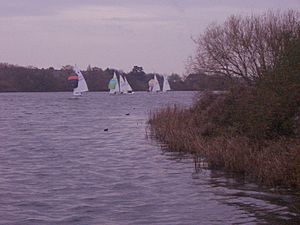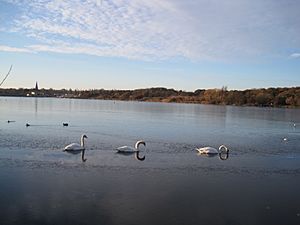Brent Reservoir facts for kids
| Site of Special Scientific Interest | |
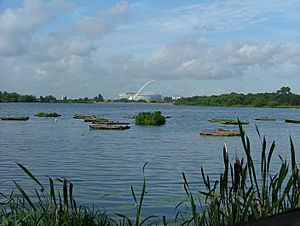 |
|
| Area of Search | Greater London |
|---|---|
| Interest | Biological |
| Area | 68.6 hectares (170 acres) |
| Notification | 1985 |
| Location map | Magic Map |
The Brent Reservoir (also known as the Welsh Harp) is a large body of water in North West London. It sits on the border between the Brent and Barnet areas. The Canal & River Trust owns it. People call it the Welsh Harp because of an old pub nearby, which was named The Welsh Harp. This reservoir is a special place for nature, covering about 68.6 hectares. It's the only Site of Special Scientific Interest (SSSI) in these two boroughs, and one of many in Greater London.
Water flows into the reservoir from the Silk Stream and the River Brent. The main outflow is also the River Brent. A smaller channel sends water to the canal system. The reservoir can hold a huge amount of water, about 1.6 million cubic meters. In 1994, when the reservoir was drained, over 6,700 pounds of fish were caught. Most of these fish were roach. However, fishing is not allowed here.
The reservoir has a sailing centre. It is home to the Welsh Harp Sailing Club, Wembley Sailing Club, the Sea Cadets, and the University of London Sailing Club. In 1960, the reservoir also hosted the Women's European Rowing Championships.
Contents
Where is the Brent Reservoir?
The reservoir is next to the A406 North Circular Road and the A5 Edgware Road. It is also a short distance north-east of Wembley Stadium. Some of the local areas around the reservoir include Neasden, Kingsbury Green, West Hendon and Cricklewood.
How the Brent Reservoir Was Built
Plans to build the reservoir started in 1803, but they were too expensive. In the early 1800s, canals were dug, but there wasn't enough water to fill them. By 1820, the Grand Union Canal and the Regent's Canal needed more water. So, in 1819, the Regent's Canal Company decided to build a dam on the River Brent. This created the reservoir and a channel to supply the Grand Union Canal. Today, it holds about 1.6 million cubic meters of water.
The reservoir was built by a contractor named William Hoof between 1834 and 1835. The water flooded much of Cockman's Farm. It was meant to supply the Regent's Canal at Paddington. The owner first named it Kingsbury Reservoir, after the local area. At first, it covered about 69 acres between Old Kingsbury Church and Edgware Road. Hoof was paid £2,740 for his work, which included building a bridge.
More building work finished in December 1837 to make the reservoir bigger. In 1841, after seven days of heavy rain, the dam collapsed. Sadly, two people died. After this, a supervisor was hired for the first time. They lived in a cottage near the dam, which is still there today.
At its biggest in 1853, the reservoir covered 400 acres. It was made smaller over time, to 195 acres in the 1890s, and later to 110 acres.
In 1859, the famous Welsh Harp tavern was built. It stood where an older inn called the Harp used to be. The tavern was taken down in the 1970s. However, the reservoir is still commonly called the Welsh Harp because of it.
Fun and Games at the Reservoir
In the late 1800s, the area became a popular spot for fun and entertainment. This was mostly thanks to W.P. Warner, who ran the Old Welsh Harp Tavern from 1858. For 40 years, Warner made the tavern one of London's most popular places. A music hall star, Annie Adams, even sang about it as 'The Jolliest Place That's Out'.
The fun wasn't just at the inn, but all around the reservoir. Warner had a race track, but it became illegal later on. The first greyhound races using mechanical hares happened here in 1876. The reservoir was also famous for Bank Holiday fairs, like nearby Hampstead Heath. Once, during its Victorian busy times, a bear escaped from a zoo here!
Water Sports at Brent Reservoir
The reservoir was once popular for speed boat races and other water sports. However, it became too small for these activities. Today, the reservoir has a sailing centre. It is home to the Welsh Harp Sailing Club, Wembley Sailing Club, the Sea Cadets, and the University of London Sailing Club. In 1960, it hosted the Women's European Rowing Championships. Over 200 competitors and officials attended, along with 5,000 spectators. The BBC and Eurovision even showed the event on TV.
Cycling Races
The first official cycle race at the Welsh Harp grounds took place on June 1, 1868. Arthur Markham won the race. He received a silver cup from the owner of the Welsh Harp Hotel, who sponsored the event. Markham later had a bicycle shop nearby.
This race happened the day after what many call the world's first race. That race was in Paris and was won by another Englishman, James Moore. His grandson believes Moore is buried near the reservoir.
Ice Skating Fun
In winter, the reservoir would freeze over, making it perfect for ice skating. National and international ice-skating events were held here. In February 1893, a man named Jack Selby even drove a coach with four horses across the frozen reservoir! As the area became more built up towards the end of the 1800s, fewer informal fun events took place.
Transport Links
The Midland Railway opened its Welsh Harp station in 1870. This was on its new line from Bedford to St. Pancras. The area became less popular as West Hendon developed between 1895 and 1915. Because of this, the station closed in 1903.
War History of the Reservoir
During World War I, the War Office used the Welsh Harp for secret tests. From 1916, they tested a new weapon: the tank. They especially tested the amphibious Mark IX tank, which could go in water. Old films of these tests were shown on British TV in the late 1990s. During World War II, people rumored that a seaplane kept on the reservoir was an escape route for the Prime Minister. Local people have shared stories of swimming to the plane.
Wildlife and Nature Conservation
When the Welsh Harp was being built, it attracted unusual birds. Bird watchers like James Edmund Harting and Frederick Bond visited often. They wrote about the birds they saw, including rare ones like the little bittern and squacco heron. This started a lasting interest in the birds of the Welsh Harp. Later, William Glegg and Eric Simms also studied the birds here.
In 1972, the Welsh Harp Conservation Group (WHCG) was formed. They worked to protect the area as a nature reserve. They even stopped a golf course from being built. The WHCG publishes reports and a book called Birds of Brent Reservoir. This book shares information about the area's history, habitats, and wildlife. The group also works with local councils to manage the site.
The reservoir and much of its shoreline are a Site of Special Scientific Interest. This is mainly because of the many different waterbirds that breed here. The area is also a Local Nature Reserve and an important site for nature conservation.
Birds of the Reservoir
The reservoir is a key place for waterbirds to breed. These include the great crested grebe, gadwall, shoveler, common pochard, tufted duck and common tern. At one point, the reservoir had the second-highest number of breeding great crested grebes in the UK. Other breeding birds include eight types of warbler. In recent years, great cormorant and grey heron have also tried to nest here, with grey herons successfully breeding since 2017.
The reservoir is known for attracting rare birds. Besides those mentioned, two black-winged stilts visited in 1918. London's first great white egret was seen here in 1997. Other rare visitors include the blue-winged teal (1996) and the lesser scaup (2003). Surprisingly for an inland spot, it also attracts rare warblers. These include the aquatic warbler (1955) and Hume's warbler (2004). The most important sighting was an Iberian chiffchaff in 1972, the first ever recorded in the UK.
So far, 253 different bird species have been recorded at the reservoir. The most recent additions are the Caspian gull (2015), Ring-necked duck (2017), and cattle egret (2018).
Insects at the Reservoir
Many insects have also been studied at the Brent Reservoir. There have been 31 types of butterfly found here. This includes breeding marbled white and ringlet butterflies. This is the closest place to central London where these can be found. The brown argus was added to the list in 2015. Before the reservoir was built, marsh fritillary butterflies used to breed here. Dragonflies and damselflies have also been studied. Fifteen species have been seen, and 12 of them breed at the reservoir.
Mammals Living Here
A small number of mammals live around the Brent Reservoir. The grey squirrel and the red fox are common. Foxes are mostly active at night. Muntjac deer have been present since the early 2000s. They are shy, so their presence is usually noted by their tracks.
The reservoir is also a great place for bats. In September 2007, five different species were recorded in one day. These included noctule, Leisler's bat, serotine, Daubenton's bat and three types of pipistrelle. Bat surveys in 2008 showed that Nathusius' pipistrelle is also present.
Neasden Recreation Ground
Neasden Recreation Ground is a park on the southern shore of the reservoir. It covers about 4.5 hectares. It has grassy areas, woods, a sports ground, and a children's play area. You can get to it from Aboyne Road and the North Circular Road.
Welsh Harp Open Space
Welsh Harp Open Space is a park and nature reserve on the north-west shore. It covers about 9.43 hectares. It was created as a recreational area in 1965. It even won a Green Flag Award in 2010–11. You can access it from Birchen Grove. In the late 1800s, this area was served by the Welsh Harp railway station.
Images for kids


